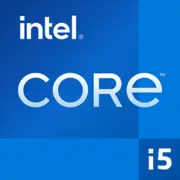Intel Core i5-13600KF

Intel Core i5-13600KF: Comprehensive Overview of the 2025 Processor
Architecture, Performance, and Use Cases
1. Key Features: Architecture and Main Features
The Intel Core i5-13600KF processor, released in 2023, remains relevant in 2025 due to its balanced performance and price point (around $270–$300). It is built on the Raptor Lake architecture and utilizes the Intel 7 process (10nm Enhanced SuperFin), which ensures high energy efficiency and transistor density.
Cores and Threads:
- 14 cores (6 Performance-cores + 8 Efficient-cores) and 20 threads.
- P-cores (Performance) operate at frequencies up to 5.1 GHz in turbo mode, while E-cores (Efficient) reach up to 3.9 GHz.
- 24 MB L3 cache accelerates data processing in games and professional applications.
Performance:
- Geekbench 6: 2718 (Single-Core), 15300 (Multi-Core).
- In games (e.g., _Cyberpunk 2077_ or _Alan Wake 2_), it demonstrates stable 120+ FPS at 1440p resolution when paired with an RTX 4070 level GPU.
- In work tasks (rendering in Blender, video encoding), it's 15–20% faster than the previous generation (Alder Lake).
Key Features:
- Support for PCIe 5.0 for future GPUs and NVMe drives.
- Intel Thread Director technology for optimizing load on hybrid cores.
- Overclocking capability (requires Z790 chipset).
2. Compatible Motherboards: Sockets and Chipsets
The processor uses the LGA 1700 socket, compatible with motherboards using:
- Z790: Best choice for overclocking (e.g., ASUS ROG Strix Z790-E, $320–$400).
- B760: Optimal choice for most users (MSI B760 Tomahawk, $180–$220).
- H770/H610: Budget boards without overclocking (Gigabyte H770M DS3H, $130–$150).
Choosing Features:
- Ensure the board supports DDR4 or DDR5 (depends on model).
- For stable overclocking, choose a board with 12+ power phases and heatsinks on VRM.
- Recommended models include Wi-Fi 6E and USB 3.2 Gen 2x2 (20 Gbps).
3. Supported Memory Types
The i5-13600KF works with DDR4-3200 and DDR5-5600, but the motherboard determines the memory type.
- DDR4: Budget option (32GB Kingston Fury Beast DDR4-3200 — $80). Suitable for gaming and everyday tasks.
- DDR5: Superior performance in professional applications (32GB G.Skill Trident Z5 DDR5-6000 — $150).
Tip: In 2025, DDR5 has become cheaper, but DDR4 is still a viable option for budget savings.
4. Power Supply Recommendations
With a TDP of 125 Watts, the processor can consume up to 180 Watts under load. For systems with RTX 4070 Ti or RX 7800 XT graphics cards:
- Minimum 650 Watts (e.g., Corsair RM650x, $110).
- For overclocking or high-end GPUs — 750–850 Watts (Seasonic Focus GX-750, $130).
Important: Choose power supplies with an 80+ Gold certification and surge protection.
5. Pros and Cons
Pros:
- Strong single-threaded performance for gaming.
- Support for DDR4/DDR5 and PCIe 5.0.
- Affordable price for a Core i5 level processor.
Cons:
- High power consumption under full load.
- Lacks integrated graphics (discrete GPU required).
- E-cores are less efficient in older, unoptimized applications.
6. Use Cases
- Gaming: Ideal for 1440p/4K with high FPS. In _Call of Duty: Warzone_, it achieves 140–160 FPS (Ultra settings).
- Work Tasks: Fast rendering in Adobe Premiere, comfortable work with 3D models in AutoCAD.
- Streaming: Load is distributed between P- and E-cores — no lag during streaming in OBS.
7. Comparison with Competitors
- AMD Ryzen 5 7600X ($280):
- Weaker in single-threaded tasks (Geekbench 6 Single-Core: 2550), but more energy-efficient (TDP 105 Watts).
- Requires expensive DDR5 and AM5 boards.
- Intel Core i5-14600K ($310):
- 5–8% faster due to Raptor Lake Refresh optimizations.
- Higher price for a slight performance increase.
Conclusion: The i5-13600KF outperforms AMD in gaming, but is surpassed by the Ryzen 7 7700X in multi-threaded tasks.
8. Practical Assembly Tips
- Cooling:
- The basic cooler is not included. Choose a tower cooler with heat pipes (DeepCool AK620, $60) or AIO (NZXT Kraken X53, $130).
- Case: Ensure adequate ventilation (Lian Li Lancool 216).
- Storage: PCIe 4.0 SSD (Samsung 980 Pro 1TB, $100) for maximum speed.
9. Final Conclusion: Who Should Consider the i5-13600KF?
This processor is an ideal choice for:
- Gamers, looking for maximum FPS without overspending on Core i7/i9.
- Content creators, working with video and 3D.
- Enthusiasts, building future-proof PCs (PCIe 5.0, DDR5).
Why in 2025?
With a price around $270, it remains the "sweet spot" between performance and cost, especially on the secondary market. However, for top-tier performance in work tasks, it's better to consider a Core i7 or Ryzen 9.
Note: All prices are accurate as of March 2025 for new devices.
Basic
CPU Specifications
Memory Specifications
Miscellaneous
Benchmarks
Compared to Other CPU
Share in social media
Or Link To Us
<a href="https://cputronic.com/cpu/intel-core-i5-13600kf" target="_blank">Intel Core i5-13600KF</a>